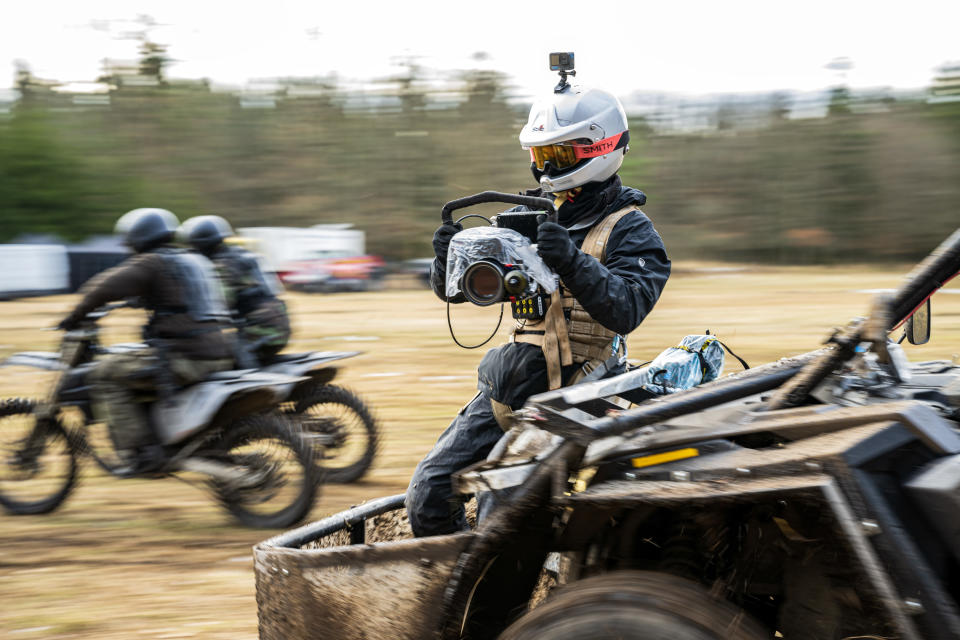Could the Best Training to Direct Movies Be Stunt Coordination?

- Oops!Something went wrong.Please try again later.
- Oops!Something went wrong.Please try again later.
- Oops!Something went wrong.Please try again later.
- Oops!Something went wrong.Please try again later.
When Netflix’s “Extraction” premiered in 2020, its elaborately constructed set pieces propelled it to become the streaming service’s most-watched original film to that point and marked director Sam Hargrave as a talent to watch. Hargrave and star Chris Hemsworth now return to the adventures of Australian black ops mercenary Tyler Rake (Hemsworth) for “Extraction 2,” a sequel that improves upon its predecessor in just about every way without losing sight of what audiences loved about the first movie. The action is bigger, the motivations more personal and affecting, and Hargrave’s command of his craft more assured.
Hargrave is part of one of the most positive trends in action filmmaking in recent years: The rise of directors with a background in stunts. The most famous examples are Chad Stahelski (the “John Wick” franchise) and David Leitch (“Atomic Blonde,” “Bullet Train“), who follow in the footsteps of ’70s and ’80s pioneers Hal Needham (“Smokey and the Bandit”) and Craig Baxley (“Action Jackson”) on the trajectory from stuntman to stunt coordinator to second unit directing and directing. And the trend is not limited to theatrical filmmaking: over in television, terrific work is being done — and on lower budgets and tighter schedules — by directors like Steve Boyum, who performed stunts on “Apocalypse Now” and is currently directing FX’s “The Old Man,” and David Barrett, who continues to moonlight as a stuntman (most recently on “Transformers: Rise of the Beasts”) even though he’s an in-demand director of episodic action series like “FBI: International” and “True Lies.”
More from IndieWire
Inside 5 Mind-Blowing Dimensions in 'Spider-Man: Across the Spider-Verse'
'Extraction 2' Review: Netflix's Brutally Entertaining Action Sequel Belongs on the Big Screen
These directors exhibit an unerring eye for blocking and choreography and are experts at placing their cameras in the most felicitous positions to capture as much visceral impact as possible. But they are also as attentive to the connective tissue between the action scenes — the performances and the quieter moments that give the action its meaning. This is certainly true of Hargrave’s work on “Extraction 2”; while the film is loaded with spectacular action — including an over-20-minute prison break that plays out in one unbroken shot — it’s also got a surprising degree of poignancy and longing, expressed by Hemsworth in one of the best performances of his career.

According to Hargrave, who was Chris Evans’ stunt double on the “Captain America” movies, his history in stunts informed both aspects of “Extraction 2.” Referring to Stahelski, Leitch, Boyum, and Barrett, Hargrave told IndieWire’s Filmmaker Toolkit podcast that “had they not been in the stunt world, they probably would have ended up being directors. There’s just a certain sensibility that lends itself to that skill set. They’re working with actors very closely during the rehearsal process, and I did a lot of that as well. So you’re communicating with actors and understanding how they think, how they operate. That on-the-job experience gives you a leg up on many directors coming out of film school. They may have the technical acumen to know where to put the camera and the lights, but in the stunt world, you’re communicating with actors on a daily basis.”
Hargrave feels that working as a stunt double for a high-level performer provides insight not only into what actors need but essential training in conveying a point of view to the crew. “As a fight choreographer, you have communication skills because you’re working with other department heads,” he said. Having 10 years of experience being on set, seeing where they put the cameras, communicating with people, understanding budgets and how long things take, and understanding the ins and outs of the filmmaking process from the standpoint of a crew member is invaluable when it comes to directing.”
For Hargrave, there were lessons to be learned both from the directors he felt were great at managing the crew — Francis Lawrence, the Russo brothers, Gavin O’Connor — and those who weren’t so great. “I’m not going to name names, but there are people who don’t communicate as well or understand the process, and you go, ‘Ah, it’s much easier to work with this person who understands what’s happening.'”
Working in stunts also gave Hargrave one of the most vital and undervalued virtues a director can have: patience. “I’ve had to sit with special effects [and deal with them] from a safety standpoint as a stunt coordinator and second unit director,” Hargrave said. “I know how long it takes to reset a car flip. So I’m not, as a director, pulling my hair out, going, ‘What’s taking so long?’ I know it’s taking so long because certain things have to happen. Same with costumes. ‘Why do we have to do this?’ Well, because they forgot to put a gusset in the jeans and we split the pants and now it’s gonna take them a second. And you’re a little more empathetic because you’ve been there on the crew side. That’s kind of a long-winded way of saying that I think those who have been in the stunt world have on-the-job experience for many, many years working with departments and with actors and that translates very well to being a director and communicating with your crew.”
Best of IndieWire
Wes Anderson Movies, Ranked: 'Bottle Rocket' to 'Asteroid City'
Where to Watch This Week's New Movies, from 'Blue Jean' to 'Transformers: Rise of the Beasts'
Sign up for Indiewire's Newsletter. For the latest news, follow us on Facebook, Twitter, and Instagram.

